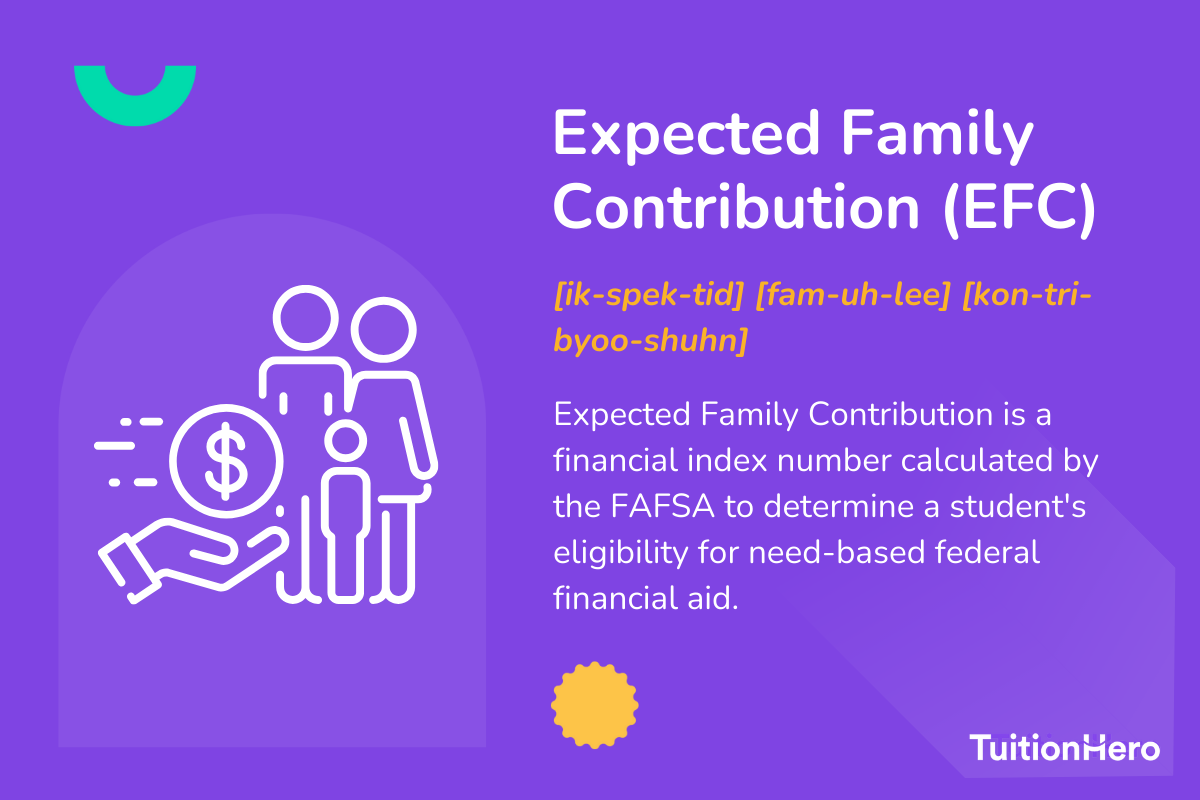Advertiser Disclosure
Last update: November 16, 2024
5 minutes read
Expected Family Contribution (EFC)
Ever wondered how your family's finances affect college aid? Learn the ins and outs of EFC and its impact on your financial aid package.

By Brian Flaherty, B.A. Economics
Edited by Rachel Lauren, B.A. in Business and Political Economy
Learn more about our editorial standards



By Brian Flaherty, B.A. Economics
Edited by Rachel Lauren, B.A. in Business and Political Economy
Learn more about our editorial standards
In college admissions, there's a term called Expected Family Contribution (EFC), which typically determines your financial aid. In this post, we'll explain EFC in more detail; you'll find out why EFC is crucial and how upcoming changes might affect you.

Key takeaways
- FAFSA is the starting point for calculating your EFC
- Changes to EFC calculation are on the horizon with the Student Aid Index
- Accurately completing the FAFSA ensures the most beneficial aid package
What is Expected Family Contribution (EFC)?
The Expected Family Contribution (EFC) is an important number that comes from your FAFSA application. Colleges use it to figure out how much financial aid you can get.
It shows how strong your family is financially and how much your family can help pay for college. Remember, the EFC is not the exact amount your family will pay for college. It's just a starting point to see how much aid you might need.

Breaking down the EFC
- The EFC comes from your financial aid application and considers income, assets, family size, and other factors.
- Despite its name, the EFC usually doesn't match what families end up paying due to more costs and financial aid considerations.
- A higher EFC indicates more family resources, while a lower EFC points to greater eligibility for aid.
Why does the EFC matter?
It's the baseline for determining your financial need and the amount of federal aid you might get, including loans, grants, and work-study programs.

TuitionHero Tip
Understanding your EFC can guide you in planning for college expenses and exploring funding options, like private student loans and scholarships.
How is the Expected Family Contribution calculated?
The methodology behind the EFC calculation takes into account a variety of financial details that paint a picture of a family's financial health. Each aspect of your financial life, from income to the size of your household, influences this important number.
The calculation process
- Your FAFSA application is the primary source for determining your EFC. Some schools also use the non-government CSS Profile to help determine financial aid.
- The formula considers assets and income from both the student and their parents, excluding retirement savings and the value of the family’s primary residence.
What information is required?
- Important data like the family’s income, assets, household size, and the number of children attending college concurrently are factored in.
- For independent students, the FAFSA uses their financial details and possibly their spouse’s rather than their parents.
Upcoming changes to EFC
The landscape of college financing is experiencing big changes, particularly with the transition from the EFC to the Student Aid Index (SAI) anticipated by the 2024-2025 school year.
What are the changes?
- A noteworthy adjustment in the financial aid process is the reduction of the FAFSA from 108 questions to a maximum of 46.
- Unlike the EFC, the SAI is not reported as a dollar amount. This will reduce confusion, since many families mistakenly believed they were required to pay the EFC amount
- Plus, the introduction of the SAI aims to clarify financial aid calculations, potentially allowing for greater aid to those in need.
Compare private student loans now
TuitionHero simplifies your student loan decision, with multiple top loans side-by-side.
Compare Rates
Effect of these changes
- These revisions are part of a broader initiative to streamline the process and make college financing more transparent and accessible.
- Starting July 1, 2023, these changes will be implemented in phases, promoting a fairer system for all applicants.
Understanding college finances is really important. To make good choices about paying for college, it helps to know about financial aid, scholarships, loans, and responsible credit card usage. Checking out scholarship options and being smart with credit cards can give useful advice for both students and families.
Now, let's focus on the numbers and trends that affect Expected Family Contribution (EFC). The table below has some important figures about EFC, and can help you make better choices with your money.
Category | Average Figures |
|---|---|
Average EFC for Community Colleges | $6,000 |
Average EFC for 4-year Colleges | $14,000 |
% of Students with EFC of $2,500 or less | Slightly more than 50% |
% of Students with EFC greater than $25,000 | Slightly more than 10% |
Federal Pell Grant Eligibility | EFC must be less than 90% of maximum grant |
Average EFC among Pell Grant Recipients | About $700 |
This table shows that students have different amounts of money and needs. It's important to know your EFC to make the most of financial aid.
Dos and don'ts of calculating your EFC
Understanding how to calculate your Expected Family Contribution (EFC) can be tricky, but here are some important steps and things to watch out for. Follow these tips to make sure you get an accurate and helpful assessment for your financial aid.
Do
Gather all necessary financial documents before starting your FAFSA application.
Use the FAFSA’s IRS Data Retrieval Tool for accuracy and ease.
Update your FAFSA if your financial situation changes significantly.
Consider utilizing a financial advisor for complex situations.
Don't
Estimate income or asset figures. Accurate reporting is crucial for an accurate EFC.
Ignore assets and income exclusions, like retirement savings or the value of the primary residence.
Assume a high EFC disqualifies you from all forms of financial aid. Other options exist.
Forget to resubmit the FAFSA every year, as financial situations and aid eligibility may change.

Advantages and disadvantages of understanding your EFC
Understanding your Expected Family Contribution (EFC) is really important for how you pay for college. It decides if you can get financial help and helps your family plan for college costs. But, dealing with EFC can be tricky because it has its own problems and limits.
- It provides a clearer picture of your financial aid eligibility, helping you plan your college expenses with more accuracy.
- Knowing your EFC can lead you to explore more financing options, like scholarships and private student loans, to cover any gaps.
- It empowers you to negotiate and appeal your financial aid package if your financial situation changes.
- A thorough EFC assessment can help maximize your eligibility for need-based aid, making sure you get the most assistance possible.
- The calculation can be complex and confusing, usually needing a significant amount of financial information and documentation.
- Changes in financial circumstances may not be immediately reflected in your EFC, potentially affecting your aid eligibility.
- Misinterpretations of assets and income can lead to inaccuracies, either inflating or deflating your EFC and impacting the aid for which you qualify.
- The transition from EFC to SAI (Student Aid Index) may introduce new complexities and uncertainties in future financial aid assessments.

Why trust TuitionHero
At TuitionHero, we simplify college financial planning with tools to understand Expected Family Contribution (EFC). We guide you through FAFSA, scholarships, private student loans, and refinancing options. Additionally, we offer student-friendly credit card recommendations. Let us help you make smart financial decisions for a better educational experience.
Frequently asked questions (FAQ)
If your financial situation changes significantly after you've filled out your FAFSA, you have the option to request a change in the amount you're expected to contribute. The first thing to do is contact the financial aid office at your college.
Share documents that show the changes, like a recent job loss or medical expenses. Keep in mind that each college has its own process for handling these requests, so make sure to follow their specific instructions. Remember, adjusting your expected contribution can have a big effect on the financial aid you receive.
If your brother or sister has money or investments, it might affect how much money you're expected to contribute for college. This is true if your sibling is part of your family's financial situation.
If your siblings are minors, their accounts may be considered part of your parent’s assets. However, if your siblings are adults or own their accounts outright, it’s unlikely that their assets would impact your EFC.
When you apply for financial aid (FAFSA), they look at your parents' money and also any money or valuable things that belong to you or your siblings. This includes things like cash deposits, investments, and trusts. But, the impact on your financial aid depends on how the assets are spread out among your family.
If you make a mistake and think your parents earn more money than they do on the FAFSA, it might make the Expected Family Contribution (EFC) higher. This could mean you get less financial aid.
Fix any mistakes by updating your FAFSA online as soon as you spot them. Making sure your information is correct helps the financial aid office figure out how much aid you really need. If you need help fixing your FAFSA, you can use TuitionHero’s FAFSA assistance for guidance and support.
Applying for and receiving scholarships will not affect your Expected Family Contribution (EFC); however, it can affect your overall financial aid package. Scholarships are considered a resource in your financial aid calculation and can reduce the amount of need-based aid you get.
Still, they're an excellent way to cover college costs without increasing your loan burden. It’s a smart strategy to get multiple scholarship opportunities. At TuitionHero, we connect students with a wide range of scholarship options to help finance their education efficiently.
Final thoughts
As we finish learning about Expected Family Contribution (EFC), remember that understanding the details is important for planning college costs. Knowing about EFC helps you confidently handle college finances.
Make sure to stay updated on changes in college financing to make the most of financial aid, scholarships, and smart borrowing options. Being informed is key to success in managing college expenses.
Source
Author

Brian Flaherty
Brian is a graduate of the University of Virginia where he earned a B.A. in Economics. After graduation, Brian spent four years working at a wealth management firm advising high-net-worth investors and institutions. During his time there, he passed the rigorous Series 65 exam and rose to a high-level strategy position.
Editor

Rachel Lauren
Rachel Lauren is the co-founder and COO of Debbie, a tech startup that offers an app to help people pay off their credit card debt for good through rewards and behavioral psychology. She was previously a venture capital investor at BDMI, as well as an equity research analyst at Credit Suisse.
At TuitionHero, we're not just passionate about our work - we take immense pride in it. Our dedicated team of writers diligently follows strict editorial standards, ensuring that every piece of content we publish is accurate, current, and highly valuable. We don't just strive for quality; we aim for excellence.
Related posts
While you're at it, here are some other college finance-related blog posts you might be interested in.
Shop and compare student financing options - 100% free!

Always free, always fast
TuitionHero is 100% free to use. Here, you can instantly view and compare multiple top lenders side-by-side.

Won’t affect credit score
Don’t worry – checking your rates with TuitionHero never impacts your credit score!

Safe and secure
We take your information's security seriously. We apply industry best practices to ensure your data is safe.
Finished scrolling? Start saving & find your private student loan rate today





